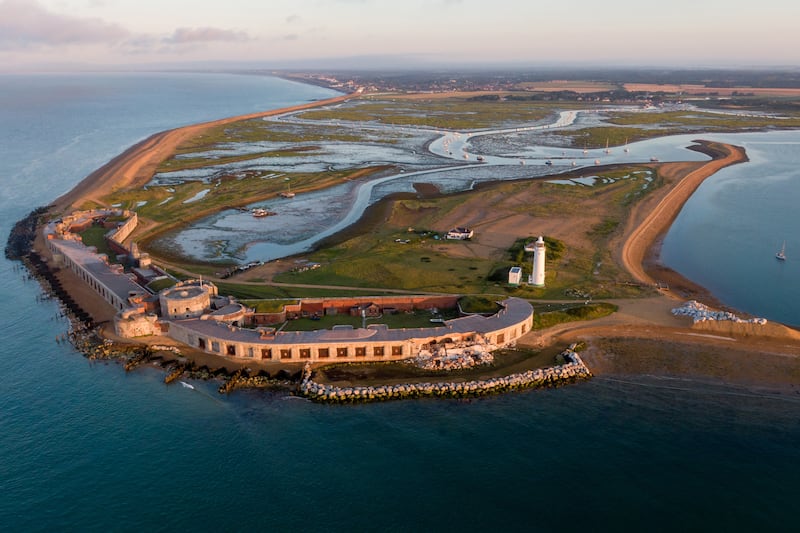Historic sites in Britain may be permanently altered by climate change, with heritage bosses considering whether to treat erosion as part of their “ongoing story”.
Coastal landmarks will become more exposed due to rising sea levels and there is an “ongoing conversation” about how far they can be preserved, The National has been told.
Extreme rainfall, flooding, heatwaves, high winds, soil subsidence and coastal erosion are all threatening historic sites, including churches, houses, castles and sites of natural significance.
With heritage sites also looking to cut their carbon footprint, conservationists are looking for ways to adapt them without spoiling their historic character.
About half of English Heritage’s carbon footprint comes from 10 large sites such as Dover Castle but “we can’t put big wind turbines there”, said Ruth Knight, the charity’s head of climate and sustainability.
A three-year action plan by English Heritage vows to map climate hazards at all 420 of its sites. The National Trust, the other main body that owns historic sites, says three quarters of its “most important land” is vulnerable.
Six castles identified as being particularly at risk include Cornwall’s Tintagel Castle, part of the legend of King Arthur, and Hampshire’s Hurst Castle, which saw a large section of its sea wall collapse in 2021.
Ms Knight told The National that “at the moment, we’re definitely looking at keeping and protecting those sites” – but stopped short of saying that all would be preserved over “long timescales”.
“We do have a few properties that are more exposed, particularly on the coastal sites. It’s an ongoing conversation about what that looks like,” Ms Knight said.
“We have a limited resource as a charity and we need to make sure that we can work across the board and conserve our sites well. Some of those sites are going to become more exposed.”

Coralie Acheson, a heritage consultant, told an event hosted by the Institution of Environmental Sciences that erosion was threatening England’s Jurassic Coast, a Unesco world heritage site.
The Jurassic Coast Trust says sea levels are “rising at a pace accelerated by human action”, leading to increased erosion rates.
Ms Acheson said there were “a lot of really interesting discussions” about how to protect the Jurassic Coast and “where the natural erosion processes are considered to be a part of its ongoing management, and part of its ongoing story.”
Soil movement
Old buildings are also under threat from subsidence, which geologists say is an increasing threat when there is hot, dry weather, causing the soil to swell and then shrink.
Movement has been spotted on church grounds and insurer Zurich says subsidence claims were up 40 per cent from January to May this year during a spell of exceptionally dry weather in Britain.
Weather forecasters have told the UK to get used to extreme heat after temperatures hit 40°C for the first time in recorded history last summer.
Unusual temperatures can also cause objects in art collections to crack, such as French enamels at a Georgian villa in London known as Ranger’s House.

“The impact of extreme heat is something that is almost a bit hidden, but will have a serious impact on some of our sites,” said Ms Knight.
“You’re seeing quite a lot of those impacts on individual types of materials and collections from extreme heat. But you’re also seeing volunteers not being able to work in those spaces because it gets too hot.”
Images last year showed Stonehenge framed against a backdrop of wildfires – a threat which heritage bosses “are expecting to see more”.
One church in Hertfordshire that was damaged by fire took another blow from last year’s Storm Eunice, which damaged several churchyard buildings and trees.
Heavy bursts of rain can easily clog up old drain pipes and the stonework at Canterbury Cathedral has been damaged by severe weather, said engineer Sarah Tattersall, who worked on the restoration of a wall at Lewes Castle.
“Our historic buildings were never designed for, never considered, the weather events that we see today,” she said.

Ms Knight said some measures to protect historic sites were “pretty unglamorous”, such as clearing gutters more often and restoring lost window shutters to protect collections.
Insurers and conservationists are turning to historic maps to understand what was there before, which can include old railway tunnels, furrows from medieval ploughing and 18th-century drainage.
These can be useful in, for example, finding new homes for wildlife as part of conservation efforts.
The World Monuments Fund has been called in to help English Heritage build sea defences for its castles and record pieces of heritage before they are lost forever.
But as with additions to Dover Castle, flood defences have to be designed “very carefully” so as not to spoil historic views, Ms Acheson said.
“Anything where we want to build a hard structure in an environment that has a lot of value for its heritage interest, we’ve got to work with those challenges,” she said.







